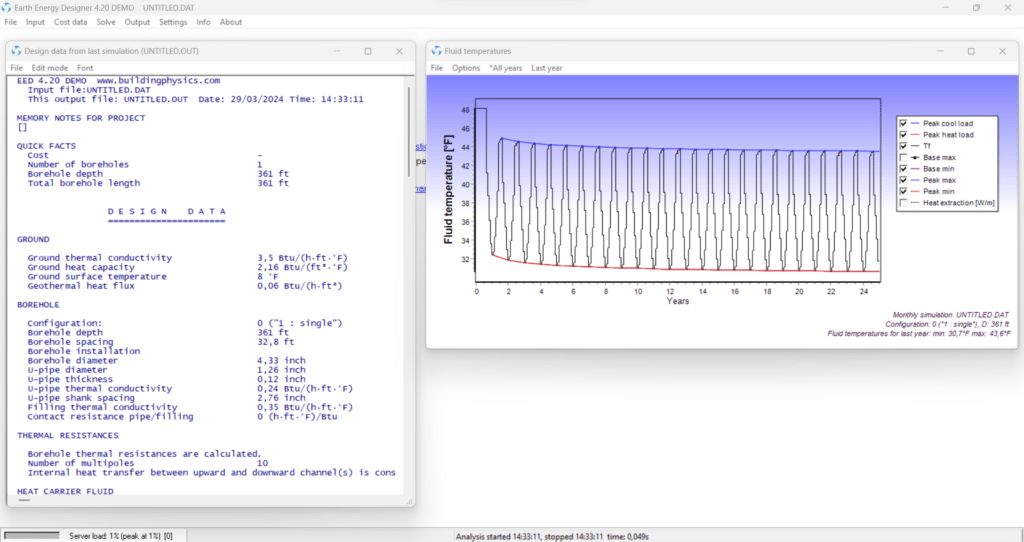EED versus GHEtool
EED (short for Earth Energy Designer) has historically been the biggest player in Europe when it comes to borefield design software. But with GHEtool, there is new player in town! In this article, we will go over both tools in more detail and explain to you their strengths and weaknesses.
EEd (Earth Energy Designer)
In 1994, Hellström and Sanner published a conference paper titled ‘Software for Dimensioning of Deep Boreholes for Heat Extraction,’ emphasizing the necessity of borefield design software over traditional rules of thumb (available on their website here). This paper stretched the importance of using computer-assisted simulations for borefield sizing. Their software, Earth Energy Designer, marked a milestone in this domain, enabling engineers and drilling firms to utilize computational tools for more precise and efficient borefield designs.
Currently, Earth Energy Designer is maintained by and available through Blocon (Sweden).

GHEtool
(ground Heat Exchanger -Tool)

GHEtool (acronym of Ground Heat Exchanger tool) was founded during the master thesis of Wouter Peere at the KU Leuven (The SySi Team). A year later, in 2021, with the support of Boydens Engineering (part of Sweco) and the FH Aachen the open-source code was shown to the public at the International Building Simulation Conference of IBPSA in Bruges (the paper can be found here). At that time, GHEtool was the first open-source based borefield sizing tool, receiving a recognition from the Journal Of Open-Source Software in 2022. GHEtool Pro, developed for professional users, was published in 2023.
Currently, GHEtool Pro is maintained by and available through Enead – energieadvies (Belgium).
Earth Energy Designer vs GHEtool
Although both tools offer the capability to design borefields, there are significant differences to consider when choosing between them.
- In practice, borefield design typically involves iterative processes, including making changes and comparing different design options. GHEtool Pro is based on such scenario analyses, allowing users to easily duplicate calculations, make adjustments, and observe the effects without altering the original scenario. In contrast, EED either overwrites previous calculations or necessitates working with multiple files, making the comparing process more cumbersome.
- As projects grow increasingly complex, borefield designs deviate further from simple rectangular configurations. GHEtool Pro offers unparalleled flexibility in borehole positioning, allowing users to input borefields with highly customized configurations directly via coordinates. In contrast, while Earth Energy Designer accommodates irregular borefield configurations, these are ultimately reduced to predefined regular options.
- Beyond borefield sizing, GHEtool Pro provides additional functionalities and assists in sizing hybrid systems. With its innovative ‘optimize load profile’ feature, users can estimate the percentage of a building load that can be met geothermally, thereby enhancing the economic feasibility of geothermal borehole projects. EED, on the other hand, is limited to borefield sizing functionalities.
- Both GHEtool Pro and EED can work with monthly and hourly load profiles for calculations. GHEtool Pro requires monthly data to be entered with absolute values, while Earth Energy Designer also offers the option to input monthly loads as percentages. When using hourly data, GHEtool Pro allows a direct import of a CSV file, whereas EED necessitates conversion to a specific *.txt file format before import.
- A crucial design criterion is the fluid regime within the borehole, whether laminar or turbulent. However, in practise, the fluid is neither laminar nor turbulent, but something in between. This fluid regime is called ’transition’, which is not modeled within EED and can result in underestimations of borehole thermal resistance. GHEtool Pro takes this third regime into account and hence calculates the fluid regime more accurately, solving the issue of underestimating the thermal resistance. (See also this article in our manual for more information.)
- Clients often demand sizing reports or calculation data for a particular project. GHEtool Pro streamlines this process by automatically exporting calculations into a ready-to-go PDF report (example report), saving both time and effort. In contrast, EED provides an exhaustive list of calculated parameters which can be used for manual reporting.
- Trial periods and demos play an important role in software selection. GHEtool Pro offers a full, unrestricted 14-day trial, while the EED demo version is limited, restricting functionalities such as loading/saving calculations, altering ground properties, and working with hourly data.
Check out our other articles
In order to facilitate your journey with GHEtool, we’ve prepared articles covering borefield sizing and general design challenges. Go and check them out.